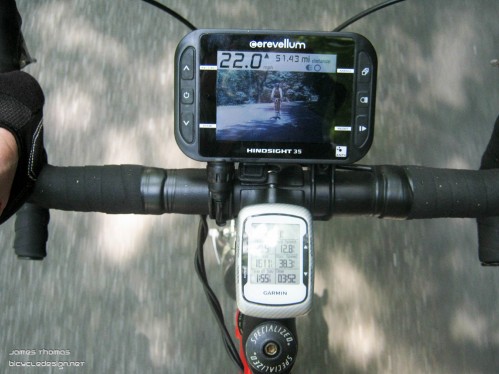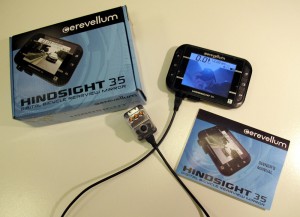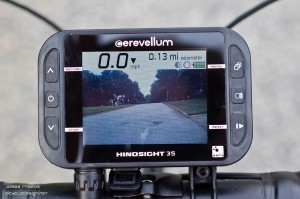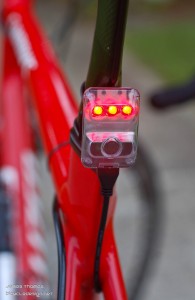 About a week before I left for China, Evan Solida, the designer and founder of Cerevellum, dropped off one of the first production Hindsight 35 units for me to try out. Some of you may remember the test ride I did with one of his early Gameboy based prototypes back in 2008…and I think you will agree that the design has come a long way since then. I have posted about Evan’s Hindsight concept a few times in the past as the concept transformed from an idea into a real product. If you are not familiar with it, you can read more about the product and what it does on the company’s website.
About a week before I left for China, Evan Solida, the designer and founder of Cerevellum, dropped off one of the first production Hindsight 35 units for me to try out. Some of you may remember the test ride I did with one of his early Gameboy based prototypes back in 2008…and I think you will agree that the design has come a long way since then. I have posted about Evan’s Hindsight concept a few times in the past as the concept transformed from an idea into a real product. If you are not familiar with it, you can read more about the product and what it does on the company’s website.
I only had a few days to ride with the Hindsight before I started traveling, so this will be a quick post based on a few rides. I plan to continue using it when I return, and will follow up with a long term review later. For now though, I want to share a few first impressions from the rides I did with Hindsight before I left.
 Installation was pretty straightforward. The bracket for the head unit clamps to the bars on either side of the stem. The head unit sides into the bracket and the camera/light module connects to it via a cable that runs along the top tube (fastened with zip ties). The camera module attaches to the seatpost or seatstay with an elastic ring (similar to the ones used on Garmin mounts). The part that fits against the post is rounded with a v-shaped groove in the center, so it fits well on a round or aero seatpost. I tried it on both and it was very secure with no movement on either bike. A standard wheel magnet and fork sensor are included to provide the speed data, and optional ANT+ accessories for cadence, heart rate, etc. will be available. You don’t have to buy a heart rate monitor from Cerevellum though. I paired my Garmin heart rate monitor with no problems. After the unit is installed, you can choose wheel size, and other settings in the menu. Also, you can choose whether video is standard view from the camera, or flipped horizontally to provide a mirror image. My first ride was with the standard view which was a bit confusing, but I believe that mirror image will be the default setting in production. The flipped mirror view with cars passing on the left is definitely more useful out on the road.
Installation was pretty straightforward. The bracket for the head unit clamps to the bars on either side of the stem. The head unit sides into the bracket and the camera/light module connects to it via a cable that runs along the top tube (fastened with zip ties). The camera module attaches to the seatpost or seatstay with an elastic ring (similar to the ones used on Garmin mounts). The part that fits against the post is rounded with a v-shaped groove in the center, so it fits well on a round or aero seatpost. I tried it on both and it was very secure with no movement on either bike. A standard wheel magnet and fork sensor are included to provide the speed data, and optional ANT+ accessories for cadence, heart rate, etc. will be available. You don’t have to buy a heart rate monitor from Cerevellum though. I paired my Garmin heart rate monitor with no problems. After the unit is installed, you can choose wheel size, and other settings in the menu. Also, you can choose whether video is standard view from the camera, or flipped horizontally to provide a mirror image. My first ride was with the standard view which was a bit confusing, but I believe that mirror image will be the default setting in production. The flipped mirror view with cars passing on the left is definitely more useful out on the road.
 After I installed the Hindsight, It took a bit of time to get used to the size of the unit. As you can see in the picture above, it is much larger that the Garmin 500 that I am used to riding with. Out on the road though, the 3.5 screen seems like a good size. You have a menu bar, which can be set at the top or bottom of the screen, for cyclo-computer functions, but most of the screen real estate is dedicated to the rear view. The transflective color screen works very well too. My first long ride with the unit was on a sunny day in the mountains of North and South Carolina. I was going from full sun to full shade on the narrow mountain roads, and the display would automatically adjust to the changing light conditions. The picture at the top of the post was taken after I had just entered the shade, and the one to the left was taken in full sun. As you can see the screen was quite readable in both conditions.
After I installed the Hindsight, It took a bit of time to get used to the size of the unit. As you can see in the picture above, it is much larger that the Garmin 500 that I am used to riding with. Out on the road though, the 3.5 screen seems like a good size. You have a menu bar, which can be set at the top or bottom of the screen, for cyclo-computer functions, but most of the screen real estate is dedicated to the rear view. The transflective color screen works very well too. My first long ride with the unit was on a sunny day in the mountains of North and South Carolina. I was going from full sun to full shade on the narrow mountain roads, and the display would automatically adjust to the changing light conditions. The picture at the top of the post was taken after I had just entered the shade, and the one to the left was taken in full sun. As you can see the screen was quite readable in both conditions.
 As you ride, video data is recorded to internal Flash memory on a continuous 5 minute loop. In the event of a crash, an accelerometer stops the recording, leaving you with a video file of the time leading up to the incident. That is the safety feature, but you can also stop the video manually by pressing a button anytime you want, after you win a sprint finish for instance. The video frame rate, bit rate, and recording time can all be adjusted in the settings menu, but the lowest settings are recommended for long rides to conserve battery life. That is something I have not really played around with yet, but I want to try to optimize the settings for longer battery life. I did one long 5 hour ride with the unit recording the entire time, and the battery died at around the 4 ½ hour mark. That is certainly long enough for the vast majority of my rides, but occasionally I like to go longer than that. I am spoiled by the battery life on my Garmin, and I certainly don’t expect a unit that is recording video on a large color display to last anywhere near as long, but I would like to find out what the max battery life is. I’ll follow up on that in a future post.
As you ride, video data is recorded to internal Flash memory on a continuous 5 minute loop. In the event of a crash, an accelerometer stops the recording, leaving you with a video file of the time leading up to the incident. That is the safety feature, but you can also stop the video manually by pressing a button anytime you want, after you win a sprint finish for instance. The video frame rate, bit rate, and recording time can all be adjusted in the settings menu, but the lowest settings are recommended for long rides to conserve battery life. That is something I have not really played around with yet, but I want to try to optimize the settings for longer battery life. I did one long 5 hour ride with the unit recording the entire time, and the battery died at around the 4 ½ hour mark. That is certainly long enough for the vast majority of my rides, but occasionally I like to go longer than that. I am spoiled by the battery life on my Garmin, and I certainly don’t expect a unit that is recording video on a large color display to last anywhere near as long, but I would like to find out what the max battery life is. I’ll follow up on that in a future post.
The unit was great for seeing cars approaching, but I also really loved being able to see the cyclists behind me in group rides. Rather than gauging shadows of a front wheel, I could tell exactly where the person behind me was if I raised the pace a bit, and I could even see the facial expression to let me know if they were hanging on comfortably or not. This would be a pretty cool tool in a race, so I am going to try that soon (if I can get away with it). As I continue to ride with the Cerevellum Hindsight 35, let me know if you have questions that I could address in a longer term follow-up post. I have really enjoyed using it so far, but I want to make sure that I answer all the questions about it that you might have about the functionality of the unit for different types of cycling.

Leave a Reply